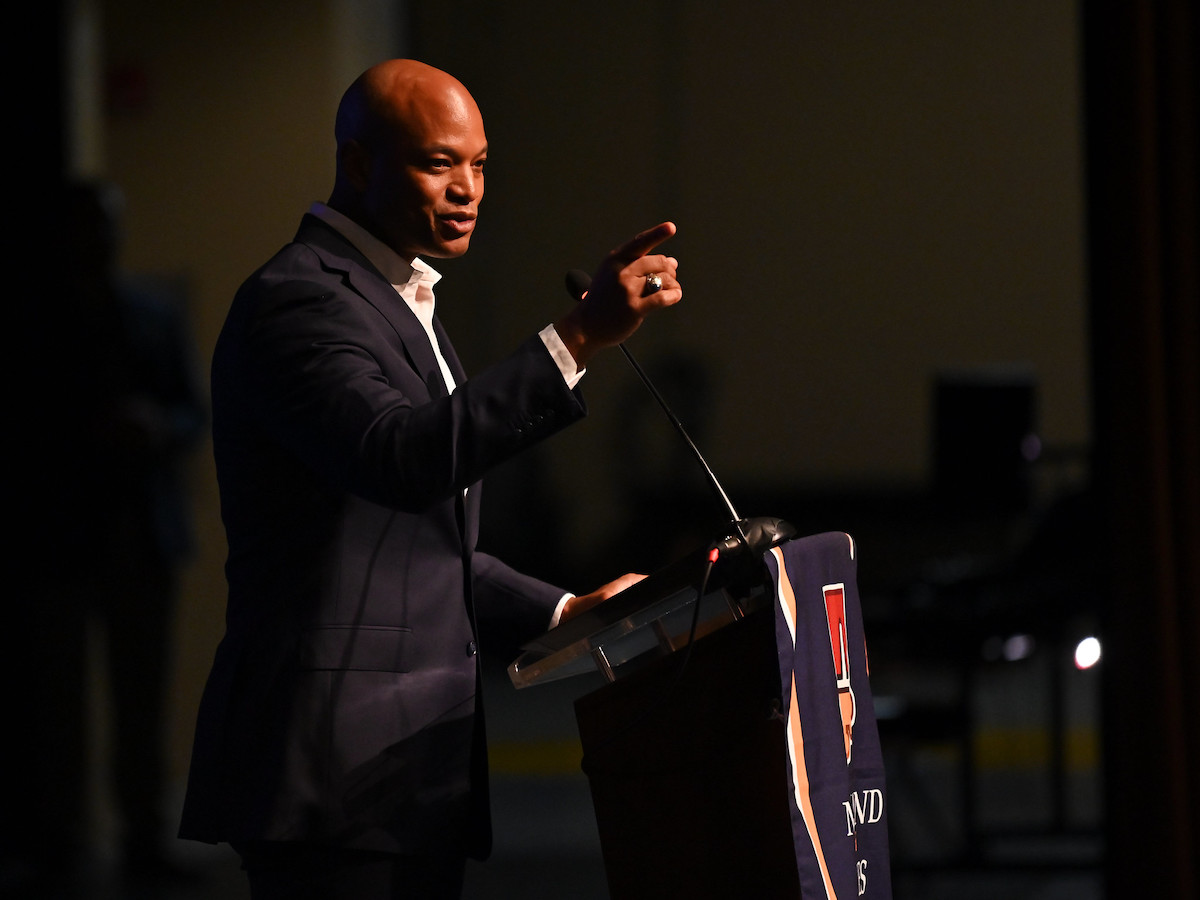
This news article was written by Danielle J. Brown and Danielle E. Gaines for Maryland Matters, where it originally appeared. It is republished here via a Creative Commons license.
Listing concerns about Maryland’s future economic outlook, Gov. Wes Moore (D) made it clear to state and county officials Saturday that there may be some hard fiscal decisions coming up in the next state budget, both for them and for himself as governor.
“It’s going to take the discipline of elected officials at the state and the local government…and yes, it is going to take the discipline of the governor. As much as I want to say ‘yes,’ you’re going to hear some ‘no’s,'” he told assembled state and county leaders at the closing address for the Maryland Association of Counties summer conference in Ocean City.
He did not get into specifics as to what the ‘no’s’ may entail — budget cuts, local project vetoes, or other options. Instead he focused on rallying the MACo attendees to work together in order to help the state reach its full economic potential.
Moore’s remarks come about a month after the Department of Legislative Services issued a report detailing state structural budget deficits that loom after his first General Assembly session, during which most of his legislative efforts were passed by a Democratic majority in Annapolis.
Deficits projected in the report for 2028 exceed $1 billion and approach levels not seen since The Great Recession.
Most of the state’s annual budget is pre-set by prior legislative mandates, and top Moore officials noted recently that 17 of the last 20 budgets have required cuts to balance.
He argued that the projections of Maryland facing economic troubles have been projected for several years, including under then-Gov. Larry Hogan (R).
“Since at least 2017, the Department of Legislative Services has been forecasting structural budget deficits. Those projections were made under the last administration — not this one. Those are their numbers, not ours,” Moore said.
The governor did not mention that an influx of federal pandemic funding in the last three years meant analysts had projected moderate surpluses earlier this year. When Moore introduced his budget in January, legislative analysts projected hundreds of millions in structural surpluses — $232 million and $263 million in fiscal years 2025 and 2026 respectively.
It is now projected that the fiscal 2025 budget will start with a $418 million deficit.
But top Moore administration officials stood by some of the pieces of legislation that have cut future revenue projections, including a measure that enhanced existing tax credits for some military retirees, a permanent extension of the state’s Earned Income Tax Credit and an acceleration of the state’s minimum wage to $15.
Those are the types of investments, top aides said, that are critical to strengthening the competitiveness of the state’s economy and families’ financial well-being.
Other budget pressures pre-date the new governor, including the General Assembly’s push for a 10-year multi-billion-dollar education reform plan, which legislative analysts have highlighted as a contributor to the projected deficits.
Moore said Saturday that the inflated federal funding that helped states weather the pandemic is expiring and contributing to the economic struggles Maryland is facing.
“The trouble underneath the surface was masked by federal cash and big stock gains during COVID,” he said. “Maryland and every other state in the nation has benefited from billions of dollars in federal money to get us through the COVID emergency. That the state of Maryland and every other state have benefited from record highs in the stock market brought in tax revenue to keep the budget healthy. But we all knew that those days would not last forever.”
The governor offered some silver linings for the uncertain state economic outlook by noting accomplishments he said will help push the economy forward, including the minimum wage increase, investing in transportation infrastructure, and keeping $2.5 billion available in the rainy day fund.
Moore and his top officials say the state has untapped potential as one of the most educated and diverse states in the country, with resources like the port of Baltimore and more than 70 federal laboratories.
By addressing broader economic conditions — the state’s economy grew at less than half of the national pace over the last decade and Maryland’s population is growing slower than neighboring states — the state’s revenue condition could improve, Moore said.
An improved economy would be key to greater income and corporate tax revenues, according to the administration. In 2022, Maryland’s personal income grew at 1.3%, while national wages went up 2.4%. (Though the state has the highest median household income in the country, according to the U.S. Census Bureau.)
During his closing address, Moore outlined a handful of guiding principles he believes will lead to a healthier budget outlook down the line, though he did not offer specific actionable steps his administration will take.
“We’re going to be prudent. We’re going to be data driven, and we will prioritize our spending in a way that strengthens our economic engine. Not just for the now, but for the future,” he said. “And discipline — discipline will be the thing that pushes us forward. The discipline to be collaborative. The discipline to be innovative. The discipline to choose the hard thing, instead of the easy thing.”
He claimed that if Maryland is able to pull itself out of its economic stagnation, neighboring states such as Virginia, New Jersey, Pennsylvania and Delaware will “will look at what we did, and they will envy our strength.”
“This is Maryland’s time. And our greatness will be won here, in this moment, together, in partnership,” Moore concluded.
Despite the uncertainty surrounding the state’s fiscal outlook, the room of MACo attendees gave the governor a standing ovation following his remarks.
_
Maryland Matters is part of States Newsroom, a network of news bureaus supported by grants and a coalition of donors as a 501c(3) public charity. Maryland Matters maintains editorial independence. Contact Editor Danielle Gaines for questions: dgaines@marylandmatters.org. Follow Maryland Matters on Facebook and Twitter.
Join the conversation!
Find news, events, jobs and people who share your interests on Technical.ly's open community Slack




